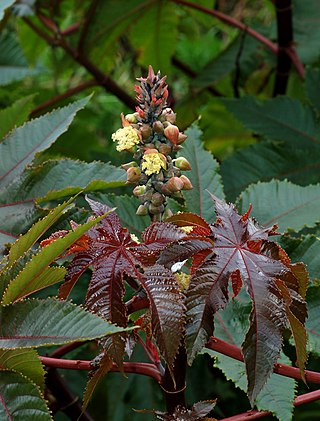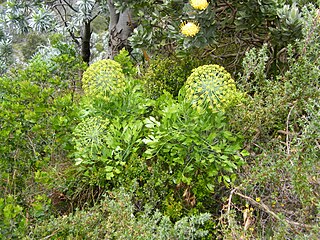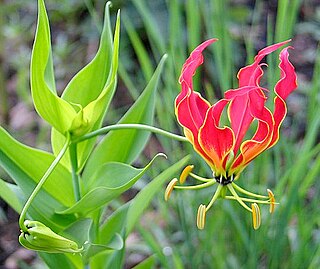
Ricinus communis, the castor bean or castor oil plant, is a species of perennial flowering plant in the spurge family, Euphorbiaceae. It is the sole species in the monotypic genus, Ricinus, and subtribe, Ricininae. The evolution of castor and its relation to other species are currently being studied using modern genetic tools. It reproduces with a mixed pollination system which favors selfing by geitonogamy but at the same time can be an out-crosser by anemophily or entomophily.

Hypericum perforatum, commonly known as St John's wort, is a flowering plant in the family Hypericaceae. It is a perennial plant that grows up to one meter tall, with many yellow flowers that have clearly visible black glands around their edges, long stamens, and three pistils. Probably a hybrid between the closely related H. attenuatum and H. maculatum that originated in Siberia, the species is now found worldwide. It is native to temperate regions across Eurasia and North Africa, and has been introduced to East Asia, Australia, New Zealand, and parts of North and South America. In many areas where it is not native, H. perforatum is considered a noxious weed. It densely covers open areas to the exclusion of native plants, and is poor grazing material. As such, methods for biocontrol have been introduced in an attempt to slow or reverse the spread of the species.

Brachystegia boehmii, named after the 19th-century German naturalist and collector Richard Böhm, is a flat-topped tree with a spreading crown, native to eastern and southern Africa. It forms an important component of miombo woodland, and occurs in Angola, Botswana, Democratic Republic of the Congo, Malawi, Mozambique, Zimbabwe, and Zambia. Common names are machabel (Mashonaland), mufuti (Zimbabwe) and Prince of Wales feathers.

Solanum mauritianum is a small tree or shrub native to South America, including Northern Argentina, Southern Brazil, Paraguay and Uruguay. Its common names include earleaf nightshade, woolly nightshade, flannel weed, bugweed, tobacco weed, tobacco bush, wild tobacco and kerosene plant.

Melia azedarach, commonly known as the chinaberry tree, pride of India, bead-tree, Cape lilac, syringa berrytree, Persian lilac, Indian lilac, or white cedar, is a species of deciduous tree in the mahogany family, Meliaceae, that is native to Indomalaya and Australasia.

Schinus terebinthifolia is a species of flowering plant in the cashew family, Anacardiaceae, that is native to subtropical and tropical South America. Common names include Brazilian peppertree, aroeira, rose pepper, broadleaved pepper tree, wilelaiki, Christmasberry tree and Florida holly. The species name has been very commonly misspelled as ‘terebinthifolius’.

Amaranthus retroflexus is a species of flowering plant in the family Amaranthaceae with several common names, including red-root amaranth, redroot pigweed, red-rooted pigweed, common amaranth, pigweed amaranth, and common tumbleweed.

Spirostachys africana is a medium-sized deciduous tree with a straight, clear trunk, occurring in the warmer parts of Southern Africa. Its wood is known as tamboti, tambotie, tambootie or tambuti.

Connaraceae is a pan-tropical plant family of 19 genera and more than 180 species of largely evergreen trees, woody shrubs and climbers.

Toona ciliata is a forest tree in the mahogany family which grows throughout South Asia from Afghanistan to Papua New Guinea and Australia.

Acalypha indica is an herbaceous annual that has catkin-like inflorescences with cup-shaped involucres surrounding the minute flowers. It is mainly known for its root being attractive to domestic cats, and for its various medicinal uses. It occurs throughout the Tropics.

Notobubon galbanum, re-classified from Peucedanum galbanum in 2008, commonly called the blister bush or hog's fennel, is a South African plant that is best known for its ability to cause painful blistering after contact. In Afrikaans this plant species is known as bergseldery.

Croton gratissimus, is a tropical African shrub or small tree with corky bark, growing to 8 m and belonging to the family of Euphorbiaceae or spurges. Young twigs are slender and angular and covered in silver and rust-coloured scales.

Thapsia villosa, commonly known as the villous deadly carrot, is a species of poisonous herbaceous plants in the genus Thapsia. It grows to about 70 to 190 cm in height. It has pinnate hairy leaves with sheath-like petioles. The flowers are yellow in color and borne on compound umbels. They develop into fruits with four wings characteristic of the genus. It is native to southwestern Europe and northwestern Africa surrounding the Mediterranean Sea. The plant was used extensively for traditional medicine since around the 3rd century BC.

Gloriosa superba is a species of flowering plant in the family Colchicaceae. Common names include flame lily, climbing lily, creeping lily, glory lily, gloriosa lily, tiger claw, agnishikha and fire lily.

Strychnos madagascariensis, the black monkey orange, is an African tropical and sub-tropical tree belonging to the Loganiaceae family. It is a tree with characteristically large fruit but can confused with some other species of the genus.

Crassula ovata, commonly known as jade plant, lucky plant, money plant or money tree, is a succulent plant with small pink or white flowers that is native to the KwaZulu-Natal and Eastern Cape provinces of South Africa, and Mozambique; it is common as a houseplant worldwide. Much of its popularity stems from the low levels of care needed; the jade plant requires little water and can survive in most indoor conditions. It is sometimes referred to as the money tree; however, Pachira aquatica also has this nickname.

Aspilia mossambicensis, also known as wild sunflower, is a medicinally useful herbaceous plant of the family Compositae (Asteraceae). It is widespread with an anthropogenic distribution in central and Eastern tropical Africa from Ethiopia, through East Africa, the Congo, Zambia, Zimbabwe, Malawi, Mozambique and South Africa.
Herb or shrub 0.5–1 m or straggling bush to 2.5 m high; branches scabrid. Leaves sessile to shortly petiolate, ovate or elliptic, 2–12´1–3 cm, base cuneate, margins entire or serrate, apex acute or attenuate, scabrid on both surfaces, somewhat 3‑nerved from base; petiole up to 1 cm long. Capitula in loose paniculate corymbs, on stalks to 7 cm long; involucre 4–7 mm high; outer phyllaries yellowish near base, green near apex, hispid‑pubescent; paleae 5–7 mm long, keeled with a dark midrib. Ray florets 8–13, bright yellow, rays 6–20 mm long, glabrous or pubescent above; disk florets yellow, 5–6.5 mm long, often with dark stripes along the tube. Achenes brown, obovoid, 4–5 mm long, pilose; pappus of several connate scales to 0.4 mm long and 1–2 barbellate aristae 1–3 mm long.
Cnestis is a genus of flowering plants belonging to the family Connaraceae.
Hugonia planchonii is a liana with bright yellow flowers that are short-lived and stems producing alternate hooks that is endemic to countries in Tropical West Africa but also occurs in Cameroon and Gabon. It is within the Linaceae family.


















